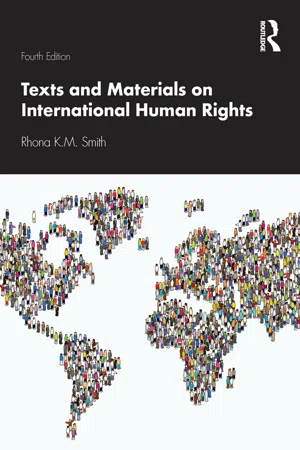
- 590 pages
- English
- ePUB (mobile friendly)
- Available on iOS & Android
Texts and Materials on International Human Rights
About this book
Texts and Materials on International Human Rights offers a carefully tailored overview of the subject that covers sources and theories, institutions and structures, and substantive rights. The fourth edition is fully updated to include all key developments in the law, in particular issues around reform in the UN and the topical application of human rights around the world.
This collection of materials offers a comprehensive overview of the institutional structures relevant to international human rights law, crucial to the understanding of how law works in this challenging area. Designed to guide students through the fundamental texts for this subject, the author's commentary contextualises each extract to explain its relevance, while highlighted further reading makes links to cutting-edge academic commentary to provide next steps for student research.
Offering a clear text design that distinguishes between materials and author commentary, and including reflective questions throughout to aid understanding, this book is ideal for students seeking to engage with the key issues in the study of international human rights.
Frequently asked questions
- Essential is ideal for learners and professionals who enjoy exploring a wide range of subjects. Access the Essential Library with 800,000+ trusted titles and best-sellers across business, personal growth, and the humanities. Includes unlimited reading time and Standard Read Aloud voice.
- Complete: Perfect for advanced learners and researchers needing full, unrestricted access. Unlock 1.4M+ books across hundreds of subjects, including academic and specialized titles. The Complete Plan also includes advanced features like Premium Read Aloud and Research Assistant.
Please note we cannot support devices running on iOS 13 and Android 7 or earlier. Learn more about using the app.
Information
Chapter 1
Sources of international human rights
Chapter contents
- What are human rights?
- Where are human rights found (i.e. sources)?
- Key principles informing international human rights.
- Practical guide to sources of human rights.
- How to research human rights (particularly primary sources).

- Convention: Binding agreement between States; used synonymously with TREATY and COVENANT. Conventions are stronger than DECLARATIONS in that they are legally binding for signatory States, and governments can be held for violating them. The United Nations GENERAL ASSEMBLY creates international norms and standards when it adopts conventions; MEMBER STATES can then ratify the UN Conventions, signifying acceptance of their obligations.
- Customary international law: Law that becomes binding on States although it is not written, but rather adhered to consistently out of custom; when enough States have begun to behave as if something is the obligatory law, it indeed becomes law; one of the main SOURCES OF INTERNATIONAL LAW.
- General principles of law: Principles that appear nearly universally in State’s domestic law and, thus, over time become binding on all States; one of the main SOURCES OF INTERNATIONAL LAW.
- Human Rights: The rights people are entitled to simply for being human, irrespective of their citizenship, nationality, race, ethnicity, language, sex, sexuality or disabilities; human rights become enforceable as they become codified as treaties, or as they become recognised as customary international law.
- Jus cogens: Those norms of law which are effectively entrenched in the international regime and are non-negotiable.
- Treaty: Formal agreement between States that defines and modifies their mutual duties and obligations; used synonymously with convention, charter, covenant. When national governments ratify treaties, they become part of their domestic legal obligations.
- Accession: Acceptance of a treaty by a State that did not participate in its negotiation or drafting.
- Adoption: Process by which a State agrees to international law; with regard to treaties, adoption usually refers to the initial diplomatic stage at which a treaty is accepted. In order to become effective, after adoption a TREATY usually must be RATIFIED by the legislature.
- Entered into Force: The day on which a treaty becomes effective; the point at which enough parties have signed on to an agreement to make it effective.
- Ratification: Process by which a legislature confirms a government’s action in signing a treaty; formal procedure by which a State becomes bound to a TREATY.
1.1 Treaties
1.1.1 What are treaties?
VIENNA CONVENTION ON THE LAW OF TREATIES 1969, Article 2(1)(a)
1.1.2 How do States agree to treaties?
- The consent of a State to be bound by a treaty is expressed by the signature of its representative when:
- (a) the treaty provides that signature shall have that effect...
Table of contents
- Cover
- Half Title
- Title
- Copyright
- Outline contents
- Detailed contents
- Preface
- Table of cases
- Table of legislation
- Table of treaties and instruments
- 1 Sources of international human rights
- 2 Key concepts: universality, interdependence and categories of rights
- 3 States and treaty obligations
- 4 Human rights organisations and key institutions: United Nations and international entities
- 5 Regional human rights organisations and key institutions
- 6 Monitoring and enforcing human rights: extra-conventional mechanisms
- 7 Implementing human rights treaties: committees and courts
- 8 Extending the duties to protect and respect human rights: non-State actors
- 9 Children
- 10 Human rights defenders
- 11 Indigenous peoples
- 12 Prisoners, detainees and convicts
- 13 Refugees, stateless persons and internally displaced persons
- 14 Women
- 15 Emerging issues and challenges
- Index